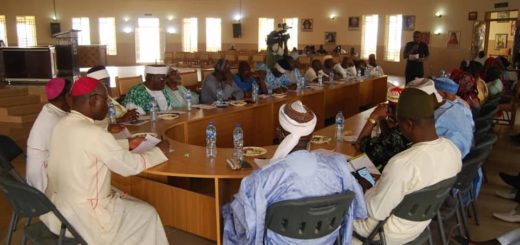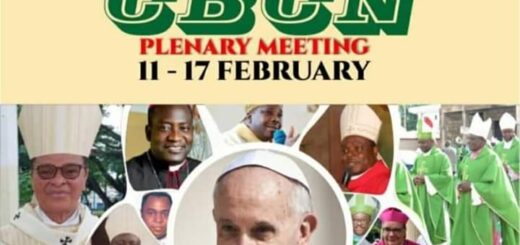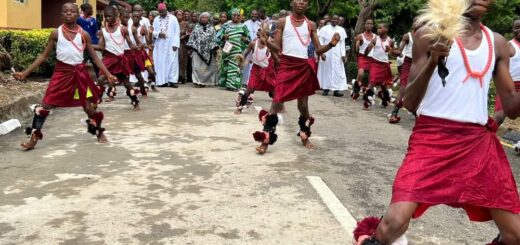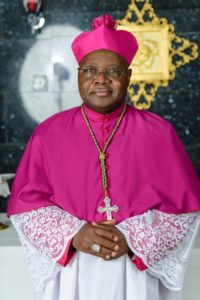CATHOLIC ARCHDIOCESE OF ABUJA: TOGETHER IN EVANGELIZATION
by ARCH BISHOP · September 4, 2020
“CATHOLIC ARCHDIOCESE OF ABUJA: TOGETHER IN EVANGELIZATION”- paper presentation by Msgr. Kenneth Enang at the Maiden General Assembly of the Catholic Archdiocese of Abuja on 4th September 2020.
It gives me great pleasure to present these few thoughts for our reflection during this august general assembly convoked by the Archbishop of Abuja, Most Rev. Ignatius Kaigama. I wish to thank him for this singular opportunity given to me, for this pleasant task.
The humble beginning : In January 1981, when I was on my way to the Rectors’ Conference in Jos, I passed through Giri and saw a sign post pointing to Abuja. I was curious to see this new capital of Nigeria which had already been widely orchestrated as Nigeria’s new capital. From a very narrow farm land path, now the airport road, I drove to the area called then the accelerated area, now Garki where we are now . The presence of human beings was scanty. The huge cranes at work to develop the new city were the most singular features. What we have now as the central business area of Abuja and Garki had scattered canteens where the first group of Federal Workers transferred from Lagos had their meals.
On 6th November 1981 an announcement filled the air that Abuja, at the request of the Nigerian Catholic Bishops, had been created as an Independent Mission with His Eminence, late Dominic Cardinal Ekandem, appointed the Superior of the Independent Mission. An independent Mission with a Superior in an uncharted territory, cut off from the peripheries of Makurdi, Lokoja and Mina dioceses? What a bold enterprise to build up a new catholic territory on no man’s land? A herculean and an audacious task indeed! Such temerity could be compared to the movement of Abraham who, by divine instructions, moved from his father’s house to where God showed him ( Gen. 12.1-8). The Superior moved to the Archbishop of Kaduna to discuss the unfolded reality with him. Preparations for the new task went ahead immediately in Ikot Ekpne and in Kaduna. Archbishop Jatau released Rev. Fr. Matthew Kukah, now Bishop of Sokoto to the Cardinal. But where would they pitch their tent because there was no single catholic church with residence in the new territory? Both had to be offered some temporary residence in Suleja by Bishop Abba of Minna diocese, from where operations for the acquisition of land and developing of church structures took place . Our first church structure was developed in St. Paul’s Gwagwalada, followed later by Garki, from where activities originated. President Shagari was kind to the Cardinal and offered him one of the so called NPN buildings where we have now our registered headquarter, Area two, Garki, Oba close.
But the finance to run the new territory was scarcely available. The financial burden in developing the new ecclesiastical designation came from Ikot Ekpene. It was not an easy beginning in terms of finance and personnel. Faith and providence played strong roles in the life of the Superior. While Ikot Ekpene played a key role in planning the first financing, Kaduna, Calabar, Makurdi, supplied the pioneer priests to help in laying the foundation of the church. Religious Congregations dropped in one by one: The Holy Ghost Fathers, the St. Patrick Fathers, the SMA, came first then came the Marist Brothers much later on. The Jesuits were preparing to come when the Cardinal retired. They met him. The first women religious who were invited to Abuja were the Handmaids, the Immaculate Heart Sisters, and then followed by the Holy Rosary Sisters and later on the Holy Family Sisters of the Needy and then last but not the least the Daughters of Divine Love. Many congregations were invited by the Cardinal to come to Abuja at that early stage, but they turned down the invitation.
The congregations were much involved in education apostolate and together with the diocesan priests, the following parishes were established, St. Paul Gwagawalada, Our Lady Queen of Nigeria, Garki, Catholic church, Gawu, Holy Rosary, Wuse , St. Mary’s Karu, SS Peter and Paul, Nyanya, St. Patrick’s Karshi, Catholic Church Abaji, Holy Family Life Camp and Bwari. There were outstations attached to these parishes which have now become parishes.
Other first vital structures. While the Missionary Seminary of St. Paul, which had already firm roots in Iperu Remo, started buildings for the formation of missionary priests in Gwagwalda, the need for the training of diocesan priests for Abuja ecclesiastical jurisdiction came into serious consideration. With the help of the Knights of St. Columbus in the United States, the Holy See and some mission agencies, the building of SS Simon and Jude in Kuje, which started in the church in Kuje, commenced at the present site.
The first Catholic Nursery School in the Independent Mission was built in Gwagwalada with the financial help from the Loyola Foundation in America. The next nursery school was the Handmaid International Nursery School in Garki. The first building there was sponsored by Ikot Ekpene diocese. Other educational establishments in the time of Cardinal Ekandem were , CKC Gwagwalada, Regina Pacis and St. Aloysius Primary school. The Jesuit College was discussed in his time and land got, but the full development was realized in the administration of his successor, His Eminence John Cardinal Onaiyekan. The CWO, the Knights of the Church and other people of goodwill played wonderful roles in the establishment of the schools in the Church of Abuja.
In the area of health apostolate, three hospitals were planned. One was to be in Bwari and was to be given to the Immaculate Heart Sisters, one in Gwagwalada to be in the hands of the Handmaids of the Holy Child Jesus and the third one was to be in Kuje. It seems that the papers for Kuje had not been found and consequently the hospital did not take off. Pope John Paul Centre was conceived in as a hospitality outfit. While it was designed to supply reception facility to visitors to Abuja, it had also in mind the spiritual welfare of the guests and those living in the neighborhood of the centre.
The Maintenance of the parishes, schools and the clergy: The maintenance of the few structures in the Independent Mission, which later became a diocese in 1989, was a very difficult. For the Missionary Clergy there was support from their congregations. The Nigerian diocesan clergy depended upon what the few but generous lay faithful contributed. Some women had to even sponsor the retreat expenses of priests.
While the Protestant church ministers were calling for tithes, the Catholic clergymen said as St. Augustine, the Jews talk about tithes, we pay no tithes. We talk about charity. Tithe payment was not an activity of the Catholic Church for her maintenance as it was known that such a practice had been banned in the Catholic Church in 1848 in the Pontificate of Pius IX.
It was a difficult period in the development of the Catholic Church in Abuja, but with the heroic sacrifices of the first church personnel and the indefatigable assistance of the few but very committed lay faithful, the church was established on a solid foundation. Our hearts are full of deep gratitude to them and may God reward them for their steadfastness and commitment to the church without looking for rewards. We hope that this will continue.
As I speak about the humble beginning, with was not without serious privations, I am not simply eulogizing the heroic sacrifices of the first pioneers. I am consciously brining this situation to the hearing of all in this august assembly because of the new evangelization which the Archbishop is initiating in the Archdiocese. We shall encounter sacrifices. We shall encounter problems of finance. We shall encounter lack of places to keep our heads. But with Providence directing us, with the help of the lay faithful, with the total commitment of the pastoral agents, a rich harvest for God is waiting for us. This happy harvest will even overtake the present fruits we have reaped today to the glory of God. We need to reflect on the early beginnings and gather sufficient courage from there to launch into the deep without fear ( Lk 5,4). I consciously give this brief description of the beginning of our church in Abuja because we live in an age that forgets easily and comfortably history and the historical foundations of things people reap. The present Vatican document draws out attention to the need not to forget the history of our church. The letter to the Hebrews says too , do not forget those who first preached the word of God to you ( Heb 13, 7).
Cardinal Onaiyekan builds on the solid foundation
As Cardinal Ekandem was gradually nearing his canonical retirement age, he asked the Holy Father for a coadjutor bishop and after three years, he was given the then Bishop of Ilorin, Most Rev. John Onaiyekan, in 1990 as his coadjutor Bishop and in 1992 he was made the Ordinarius of Abuja diocese. In an accelerated fashion, Most Rev. John Onaiyekan became an Archbishop in 1994, and in 2012 he became a Cardinal.
We must give the Cardinal the credit for the further pastoral development of the Church in Abuja. It is in his time that the scramble for Abuja by religious Congregations, both men and women, took place. It is in his time that we get many many seminarians, many diocesan priests, more parochial and diocesan schools.
With the appointment of his Auxiliary, Most Rev. Anselm Umoren, MSP, in 2012, evangelization progressed and more parishes came up. May God bless both of them. Bishop Anselm Umoren will continue to be a strong helper of the new local Ordinary to advance the progress of the Archdiocese to enviable heights. Already there are indications to lofty progress and when we hopefully celebrate next year forty years of our existence as a catholic jurisdiction we shall sing songs of praise to God.
Our New Evangelization:
On the 28th of last month during the ceremony of the Pallium, the Archbishop of Abuja, Most Rev. Ignatius Kaigama, announced the creation of thirty evangelization out posts which would develop gradually into Quasi or full pledged parishes in the future. This is in line with the directives from the Holy See published on 7th July 2020 and entitled: THE PASTORAL CONVERSION OF THE PARISH COMMUNITY IN THE SERVICE OF THE EVANGELIZING MISSION OF THE CHURCH”. The Vatican document calls such pastoral centres.
The document is based on three principal doctrinal teachings of the Second Vatican Council, with specific reference on Lumen Gentium , widely supported by Canon Law and Christus Dominus. These doctrinal teachings namely the nature of the church, the office of the Bishop and the position of the lay faithful in the church.
1.The Nature of the church: The nature of the church is missionary ( LG 1). The church of the New Testament is missionary by its very nature ( Cardinal Walter Kasper, the Catholic Church.2017, 292).
2.The office of the Bishop: Bishop is the authentic teacher of faith ( CD.2).The Bishop is the first evangelizer in his jurisdiction. He is to do his utmost to ensure that the activities of evangelization and the apostolate are zealously supported and promoted by the faithful (CD6).
3.The laity : The laity are those incorporated by Baptism into Christ and by virtue of this baptism share, to the best of their ability, in the mission of the whole church (LG 31).
The document is addressed to the entire universal church. Its aim is to encourage the redeemed people, according to their status in the church to promote new evangelization to all nooks and crannies of the world. It is intended to help the older church not to remain stagnant and close down churches because of the scarcity of priests but explore new ways of keeping the Christian people alive and healthy around the Eucharistic table of the Lord. Some dioceses in Europe have closed their churches because of the scarcity of priests and some plan reducing the number of parishes into pastoral units. The church says no. Rather, the faithful of Christ should explore various possibilities offered by Canon Law to get as many people involved in evangelization because they have the responsibility towards the furthering of the mission of Christ.
For us in the young churches, the document encourages our churches, the Bishops as leaders, the priests, the religious, male and female and the entire laity to, keeping to the norms of the church and its long history, carry the evangelizing mission of the church into many unexplored geographical areas within their ecclesiastical territories. While doing that, abuses should be checked. All of us in Abuja Archdiocese are challenged to take up this divine obligation with vigour and pastoral zeal. In view of this intention, the theme of this assembly is therefore most appropriate: Together in Evangelization.
What does this mean to us as a church in Abuja? The Vatican document gives us clearly the tone of our responsibility: we are to seek new ways and methods on how best we are to proclaim the Gospel in a way and manner most suitable to our Archdiocese. Under the guidance of the Bishop, we are to search for harmonious synthesis of our various charismas and vocations to proclaim the gospel and Pope Francis adds that for this task, the teaching of the church and Canon Law give innumerable possibilities, and freedom to seek these things. This is called New Evangelization. We must make determined missionary decision capable of transforming things and channeled towards evangelization.
The parish, the centre of Evangelization:
The document marks out the parish as the centre for evangelization. This means that the parish is the fulcrum from which radiates all pastoral activities. Quoting the three Pontiffs of our time, the document says that the Parish holds an eminent position to promote evangelization which is the corner stone of all pastoral action. It is in parishes that the centrality of the missionary dimension of the church is nourished by all: starting from the parish priests, to the deacons, the religious, lay men and women, the youth and even children.
It is in the parish that the saving work of Christ in the sacraments is most celebrated and where everyone works for the common good ( I Cor 12,12-27). The Holy Eucharist which is the source and the summit of the whole Christian life (LG 11). When it is celebrated worthily as laid down by the church, the death and resurrection of the Lord is proclaimed. The Holy Eucharist is a gift of God to the church and nobody has the right to alter or add anything to it, contrary to the norms prescribed by the church (Pope Benedict 2012). The Holy Eucharist gives the faithful of Christ, the needed spiritual strength to undertake Evangelization so that the entire community of believers may understand their responsibilities to evangelize. In celebrating the Holy Eucharist, the document emphasizes in art. 40 that care must be taken not to commercialize the Sacramental life and not to give the impression that of the Sacraments, especially the Holy Eucharist , along with other ministerial activities are subject to tariffs. In art. 118 the document emphasizes again the need for offerings given at mass and other sacramental celebrations to be freely given and should not be subject to payments or tariffs. No sacrament should be taxed. In art. 121 the document again reiterates that receiving free offerings is good and it is be encouraged, but that even if it is given freely, the giver should not feel the obligation to respond to an expectation or price.
Other forms of pastoral care:
The diocesan Bishop is to provide pastoral care, apart from parishes or quasi parishes. , weighing, for example, the establishment of pastoral centres, dependent upon local parishes. This means that the pastoral centres are not autonomous catholic communities but are part and parcel of the pastoral life of the mother parish. Such centres could be called mission stations created to promote evangelization and charity. For such cases, diocesan norms have to be followed.
The parochial vicar, named also assistant priest or curate can be assigned to help in such centres. But he is to work in close collaboration with the parish priest. The curate promotes in such pastoral centres evangelization as a mission of the church. The pastoral centres are missionary outposts and are favourable for proximity to the people, and ensures moments of prayer, and if suitable Eucharistic adoration. Such pastoral units are very useful to keep the people together and should grow in faith so that the Bishop in the course of years could make them parishes.
A note of warning is appropriate here. Adoration mentioned here is not what an individual priest should create as we have seen in Nigeria. Such adoration grounds have become breeding grounds for the revival of African Traditional Religion, Syncretism , heresies and practices of Pentecostalism. Not long ago, Bishop Urgoji of Umauahia and the Apostolic Administrator of Ahiara had to pluck serious courage to ban one of such grounds and deprive the priest involved of priestly faculties.
Care of the poor: Charity to the poor has been a dimension of the evangelizing mission of the church. The document emphasizes it.
Pastoral care of the youth and those who have deserted their Catholic Faith are important in the new Era of Evangelization. I congratulate the Archbishop for his vision of this new evangelization which is a task of all of us: priests, deacons, the religious and the lay faithful. The success of this new approach to evangelization could be a model for other dioceses in Nigeria. The new undertaking will involve sacrifice and heavy financial support and we have to face it.
Thanks for listening and for your undisputed readiness to cooperate. May Mary, the Mother of the Missions help us in this onerous task. Amen
Msgr. Kenneth Enang




